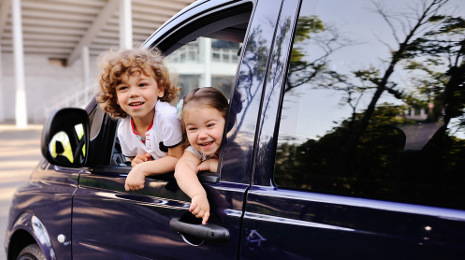Survey finds parents who taxi prefer bigger vehicles

A recent study found that a bigger car could be the key to a better family driving experience.
CarGurus’ Family Driving Survey found that parents who drive multiple children around in sedans are less satisfied with their vehicles than those driving minivans and SUVs.
Twenty-one percent of sedan owners said their car does not meet their family’s needs, while only 7 percent of minivan and SUV owners expressed dissatisfaction.
Of all the respondents reporting that their current primary car does not meet their family's driving needs, 62 percent said it’s because the car is too small.
“Parents weigh many important factors when they consider their family car, but it seems that bigger capacity is one of the best indicators for overall satisfaction, especially as kids grow up,” said Matt Smith, editor at CarGurus.
“The benefits of more space and improved comfort and convenience features are huge for families, and manufacturers are delivering on these bigger expectations at many budgets and with improved fuel efficiency. Sustained low gas prices also make the super-sized ride a lot more palatable for families.”
But while minivans and SUVs may be the preference for families with multiple children, buyers are not likely to find deals on these vehicles right now.
“The bottom line for shoppers is that following the crowd will cost you,” said Brian Moody, executive editor at Autotrader. “With so many SUVs and CUVs selling well — Honda HR-V, for example — great deals are not likely on those vehicles. Be prepared to pay full price.”
What’s happening in the family automobile
Families today are spending a lot of time on the road and doing a lot of “living” in their cars. More than half (56 percent) of parents with middle-school-age children report they are driving their kids to and from school or extracurricular activities at least five days per week. One in three middle school parents report spending four hours or more per week driving their kids around.
Almost half of parents surveyed (45 percent) said they are most likely to have a conversation with their children about their day while driving in the car versus at the dinner table or at bedtime.
Besides conversation, a lot more “family room” activity is happening in the car. A majority of parents allow their children to:
—Eat in the car (78 percent)
—Read in the car (73 percent)
—Use mobile devices to play games or watch media online (70 percent)
—Choose the music for the ride (60 percent)
When families with multiple children were asked which feature would be of primary importance when considering purchasing a family car today, price, safety, cargo capacity and fuel economy ranked the highest out of 12 features.
Family-friendly features such entertainment technology and video screens, and convenience features such as an automatic tailgate lift were of least importance to most parents. Resale value was also not a high priority for families with multiple children. This feedback helped inform CarGurus’ choices for Best Family Cars for 2016, which can be found here.
While September was a lackluster month for new car sales, Americans’ passion for larger vehicles is supplanting the popularity of smaller models.
“Even as the Big Three U.S. automakers fail to show sales increases in September, and records are not being set, the numbers are still historically solid. Low fuel prices and a consumer passion for crossovers, SUVs and trucks continues to buoy sales of those models as traditional sedans and coupes fall out of favor,” said Michael Harley, analyst for Kelley Blue Book.
According to the American International Auto Dealers Association, crossover SUVs and pickup trucks accounted for 59.9 percent of all vehicle sales in September — up 4.5 percent from last September — while car sales were down 7.1 percent to 40.1 percent of all vehicles sold.
CarGurus gathered online responses from 1,400 parents with children 18 or younger on their family driving behaviors and vehicle needs. Click here to view the full results.

 View The Latest Edition
View The Latest Edition

